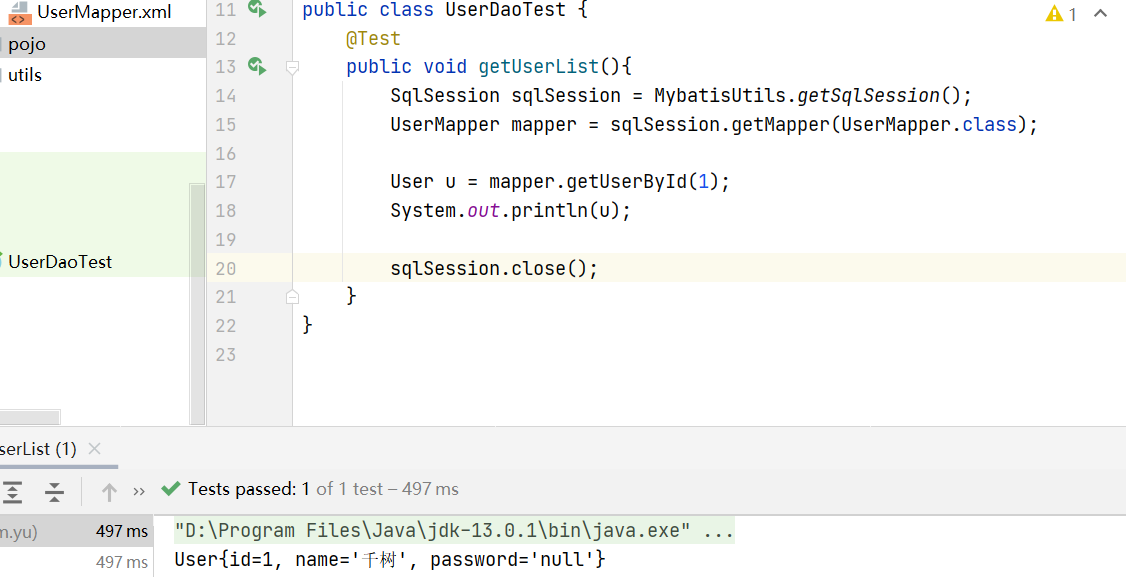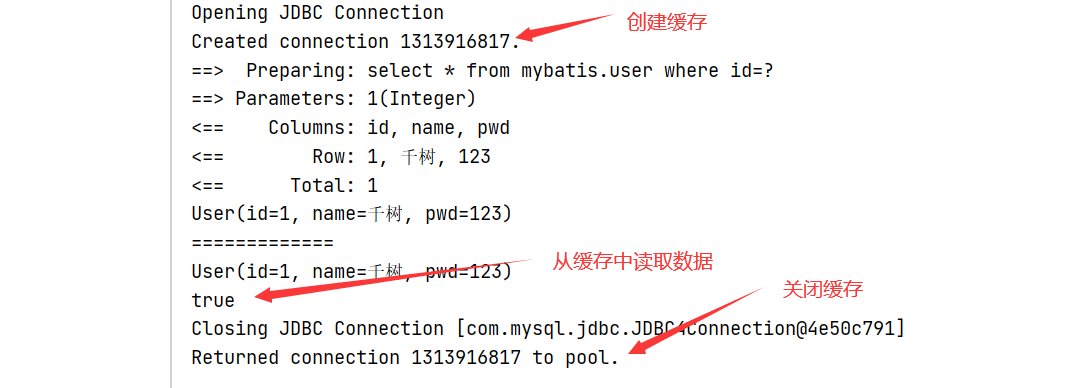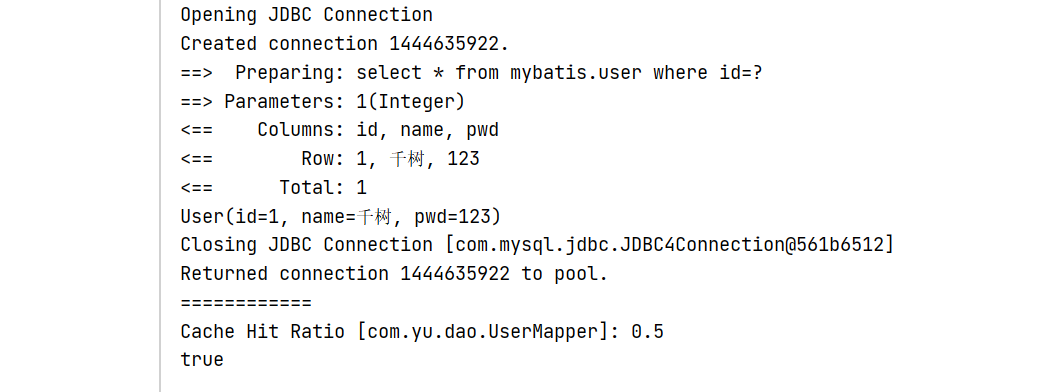1 简介
1.1什么是Mybatis
-
MyBatis是一款优秀的持久层框架
-
支持定制SQL、存储过程以及高级映射
-
Mybatis避免了几乎所有的JDBC代码和手动设置参树,以及获取结果集
-
Mybatis可以使用简单的XML或注解来配置和映射原生类型、接口和Java的POJO(Plain Old Java Objects,普通老式Java对象)为数据库中的记录
-
MyBatis本是apache的一个开源项目iBatis
-
2010年这个项目由apache software foundation迁移到了谷歌代码,并且改名为MyBatis
-
2013年11月迁移到Github
如何获得Mybatis?
-
`Maven仓库:下载地址
Github:Mybatis地址- 中文文档地址
1.2 持久化
数据持久化
-
持久化就是将程序的数据保存在硬盘中
-
内存特性:断电会失去信息
-
数据库(jdbc),io文件持久化
-
生活中的持久化:冷藏,写…
为什么需要持久化?
- 我们需要将一些数据保存下来,方便以后使用
- 内存价格过高(制造成本高)
1.3 持久层
复习学习过的层:Dao,Service,Controller
持久层的工作
- 完成持久化工作的代码块
- 层之间的接线非常明显
1.4 为什么需要MyBatis?
- 帮助程序员将数据存入到数据库中
- 传统的JDBC代码太复杂了
- 简化、框架、自动化
- 不用Mybatis也能实现,Mybatis可以使程序员在不知道底层原理的情况下,完成网站后台搭建
- 优点:
- 简单易学
- 灵活
- 解除sql与程序代码的耦合
- 提供映射标签,支持对象与数据库的orm字段关系映射
- 提供对象关系映射标签,支持对象关系组建维护
- 提供xml标签,支持编写动态sql。
2 第一个MyBatis程序
思路:搭建环境–>导入Mybatis–>编写代码–>测试
2.1 搭建环境
搭建mysql
新建项目
1.新建一个maven项目
2.删除src目录
3.导入maven依赖
```xml
<dependencies>
<!--mysql驱动-->
<dependency>
<groupId>mysql</groupId>
<artifactId>mysql-connector-java</artifactId>
<version>8.0.30</version>
</dependency>
<!--mybatis-->
<dependency>
<groupId>org.mybatis</groupId>
<artifactId>mybatis</artifactId>
<version>3.5.6</version>
</dependency>
<dependency>
<groupId>junit</groupId>
<artifactId>junit</artifactId>
<version>4.12</version>
</dependency>
</dependencies>
<!-- 在build中配置resources 来防止我们资源导出失败问题-->
<build>
<resources>
<resource>
<directory>src/main/resources</directory>
<includes>
<include>**/*.properties</include>
<include>**/*.xml</include>
</includes>
<filtering>true</filtering>
</resource>
<resource>
<directory>src/main/java</directory>
<includes>
<include>**/*.properties</include>
<include>**/*.xml</include>
</includes>
<filtering>true</filtering>
</resource>
</resources>
</build>
2.2 创建一个模块
-
编写mybatis核心配置文件
<?xml version="1.0" encoding="utf-8" ?> <!DOCTYPE configuration PUBLIC "-//mybatis.org//DTD Config 3.0//EN" "https://mybatis.org/dtd/mybatis-3-config.dtd"> <!--configuration 核心配置文件--> <configuration> <environments default="development"> <environment id="development"> <transactionManager type="JDBC"/> <dataSource type="POOLED"> <property name="driver" value="com.mysql.cj.jdbc.Driver"/> <property name="url" value="jdbc:mysql://localhost:3306/mybatis?useSSL=true&useUnicode=true&characterEncoding=UTF-8"/> <property name="username" value="root"/> <property name="password" value="0414"/> </dataSource> </environment> </environments> <!-- 每一个Mapper.xml都需要在Mybatis核心配置文件中注册--> <mappers> <mapper resource="com/lei/dao/UserMapper.xml"/> </mappers> </configuration> -
编写mybatis工具类
public class MybatisUtils { private static SqlSessionFactory sqlSessionFactory; static { try { String resource = "mybatis-config.xml"; InputStream inputStream = Resources.getResourceAsStream(resource); sqlSessionFactory = new SqlSessionFactoryBuilder().build(inputStream); } catch (IOException e) { e.printStackTrace(); } } //既然有了 SqlSessionFactory,顾名思义,我们可以从中获得 SqlSession 的实例。 // SqlSession 提供了在数据库执行 SQL 命令所需的所有方法。你可以通过 SqlSession 实例来直接执行已映射的 SQL 语句 public static SqlSession getSqlSession(){ return sqlSessionFactory.openSession(); } }
2.3 编写代码
-
实体类
public class User { private int id; private String name; private String pwd; public User() { } public User(int id, String name, String pwd) { this.id = id; this.name = name; this.pwd = pwd; } public int getId() { return id; } public void setId(int id) { this.id = id; } public String getName() { return name; } public void setName(String name) { this.name = name; } public String getPwd() { return pwd; } public void setPwd(String pwd) { this.pwd = pwd; } } -
dao接口
public interface UserDao { List<User> getUserList(); } -
接口实现类由原来的userDaoImp转变为配置一个Mapper配置文件
<?xml version="1.0" encoding="UTF-8" ?> <!DOCTYPE mapper PUBLIC "-//mybatis.org//DTD Mapper 3.0//EN" "https://mybatis.org/dtd/mybatis-3-mapper.dtd"> <!--namespace=绑定一个对应的mapper接口--> <mapper namespace="com.lei.dao.UserDao"> <!-- select查询语句--> <select id="getUserList" resultType="com.lei.pojo.User"> select * from mybatis.user </select> </mapper>
2.4 测试
@Test
public void test(){
//第一步 获得 sqlSession对象
SqlSession sqlSession = MybatisUtils.getSqlSession();
//方式1执行sql
UserDao mapper = sqlSession.getMapper(UserDao.class);
List<User> userList = mapper.getUserList();
for (User user:userList){
System.out.println(user);
}
sqlSession.close();
}
测试结果
[外链图片转存失败,源站可能有防盗链机制,建议将图片保存下来直接上传(img-e2xn3A4p-1667903639478)(C:\Users\lll\AppData\Roaming\Typora\typora-user-images\image-20221023233628594.png)]
3 CRUD
1.namespace
namespace中的包1名要和Dao/mapper接口的包名一致
2.select
选择,查询语句
- id:就是对应namespace中的方法名
- reuItType:Sql语句执行的返回值
- parameterTypeparameterType 参数类型
1.编写接口
//查询全部用户
List<User> getUserList();
//根据id查询
User getUserById(int id);
2.编写对应的mapper中的sql语句
<!-- select查询语句-->
<select id="getUserList" resultType="com.lei.pojo.User" >
select * from mybatis.user
</select>
<select id="getUserById" parameterType="int" resultType="com.lei.pojo.User ">
SELECT *FROM mybatis.user WHERE id=#{id}
</select>
3测试
public void test(){
//第一步 获得 sqlSession对象
SqlSession sqlSession = MybatisUtils.getSqlSession();
//方式1执行sql
UserMapper mapper = sqlSession.getMapper(UserMapper.class);
List<User> userList = mapper.getUserList();
for (User user:userList){
System.out.println(user.toString());
}
sqlSession.close();
}
@Test
public void getUserById(){
SqlSession sqlSession = MybatisUtils.getSqlSession();
UserMapper mapper = sqlSession.getMapper(UserMapper.class);
User userById = mapper.getUserById(1);
System.out.println(userById);
sqlSession.close();
}
3.Insert
<insert id="addUser" parameterType="com.lei.pojo.User" >
insert into mybatis.user (id, name, pwd) VALUES (#{id},#{name},#{pwd})
</insert>
4.update
<update id="updateUser" parameterType="com.lei.pojo.User">
update mybatis.user set name = #{name},pwd=#{pwd} where id = #{id};
</update>
5.delete
<delete id="deleteUser" parameterType="int">
delete from mybatis.user WHERE id=#{id};
</delete>
public void getUserLike(){
//第一步 获得 sqlSession对象
SqlSession sqlSession = MybatisUtils.getSqlSession();
//方式1执行sql
UserMapper mapper = sqlSession.getMapper(UserMapper.class);
java.util.List<com.lei.pojo.User> userList = mapper.getUserLike("%李%");
for (User user:userList){
System.out.println(user);
}
sqlSession.close();
}
@Test
public void test(){
//第一步 获得 sqlSession对象
SqlSession sqlSession = MybatisUtils.getSqlSession();
//方式1执行sql
UserMapper mapper = sqlSession.getMapper(UserMapper.class);
List<User> userList = mapper.getUserList();
for (User user:userList){
System.out.println(user.toString());
}
sqlSession.close();
}
@Test
public void getUserById(){
SqlSession sqlSession = MybatisUtils.getSqlSession();
UserMapper mapper = sqlSession.getMapper(UserMapper.class);
User userById = mapper.getUserById(1);
System.out.println(userById);
sqlSession.close();
}
//增删改需要提交事务
@Test
public void addUser(){
SqlSession sqlSession = MybatisUtils.getSqlSession();
UserMapper mapper = sqlSession.getMapper(UserMapper.class);
int hh = mapper.addUser(new User(4, "ccc", "12345"));
if (hh>0){
System.out.println("插入成功");
}
//提交事务
sqlSession.commit();
sqlSession.close();
}
public void addUser2(){
org.apache.ibatis.session.SqlSession sqlSession = com.lei.utils.MybatisUtils.getSqlSession();
com.lei.dao.UserMapper mapper = sqlSession.getMapper(com.lei.dao.UserMapper.class);
java.util.HashMap<String, Object> map = new java.util.HashMap<String, Object>();
map.put("lid",5);
map.put("lname","大小");
map.put("lid","125");
mapper.addUser2(map);
}
@Test
public void upadteUser(){
SqlSession sqlSession = MybatisUtils.getSqlSession();
UserMapper mapper = sqlSession.getMapper(UserMapper.class);
mapper.updateUser(new User(4,"哈哈","123123"));
sqlSession.commit();
sqlSession.close();
}
@Test
public void deleteUser(){
SqlSession sqlSession = MybatisUtils.getSqlSession();
UserMapper mapper = sqlSession.getMapper(UserMapper.class);
mapper.deleteUser(4);
sqlSession.commit();
sqlSession.close();
}
注意:
- 增删改需要提交事务 sqlSession.commit();
6分析错误
- 标签不要匹配错误
- resource 绑定 mapper 需要使用路径
- 程序配置文件必须符合规范
7万能的mapper方法
我们的实体类,或数据库中的表,字段或参数过多,我们应该考虑map
//万能的map
User addUser2(java.util.Map<String , Object> map) ;
<!-- 对象之中的,可以直接取出来 传递map的key-->
<insert id="addUser2" parameterType="map">
insert into mybatis.user(id, name, pwd) values (#{lid},#{lname},#{lpwd})
</insert>
public void addUser2(){
org.apache.ibatis.session.SqlSession sqlSession = com.lei.utils.MybatisUtils.getSqlSession();
com.lei.dao.UserMapper mapper = sqlSession.getMapper(com.lei.dao.UserMapper.class);
java.util.HashMap<String, Object> map = new java.util.HashMap<String, Object>();
map.put("lid",5);
map.put("lname","大小");
map.put("lid","125");
8模糊查询
1.java代码执行的时候,传递通配符% %
List<com.lei.pojo.User> userList = mapper.getUserLike("%李%");
接口
List<User> getUserLike(String value);
sql语句
<select id="getUserLike" resultType="com.lei.pojo.User">
select * from mybatis.user u where name like #{value}
</select>
测试
public void getUserLike(){
//第一步 获得 sqlSession对象
SqlSession sqlSession = MybatisUtils.getSqlSession();
//方式1执行sql
UserMapper mapper = sqlSession.getMapper(UserMapper.class);
java.util.List<com.lei.pojo.User> userList = mapper.getUserLike("%李%");
for (User user:userList){
System.out.println(user);
}
sqlSession.close();
}
结果
查询结果
User{id=3, name='李四', pwd='1234'}
User{id=4, name='李五', pwd='147'}
4.配置解析
1.核心配置文件
- mybatis-config.xml
- mybatis 的配置文件影响mybatis 行为的设置和属性信息
properties(属性)
settings(设置)
typeAliases(类型别名)
typeHandlers(类型处理器)
objectFactory(对象工厂)
plugins(插件)
environments(环境配置)
environment(环境变量)
transactionManager(事务管理器)
dataSource(数据源)
databaseIdProvider(数据库厂商标识)
mappers(映射器)
2.环境配置(environments)
MyBatis 可以配置成适应多种环境但每个 SqlSessionFactory 实例只能选择一种环境。
学会使用配置多套运行环境
mybatis默认的事务管理器就是JDBC 连接池:POOLED
3.属性(properties)
我们可以通过properties属性来实现引用配置文件
这些属性可以在外部进行配置,并可以进行动态替换。你既可以在典型的 Java 属性文件中配置,也可以在 properties 元素的子元素中设置。
编写一个配置文件
dp.properties
driver=com.mysql.cj.jdbc.Driver
url=jdbc:mysql://localhost:3306/mybatis?useSSL=true&useUnicode=true&characterEncoding=UTF-8
username=root
password=0414
在核心配置文件引入
<!-- 引入配置文件-->
<properties resource="dp.properties">
<property name="username" value="root"/>
<property name="password" value="123"/>
</properties>
- 可以直接引入外部文件
- 可以在其中增加一些属性配置
- 如果两个文件有同一个字段,优先使用外部配置文件
4.类型别名(typeAliases)
-
类型别名可为 Java 类型设置一个缩写名字。
-
存在意义在于降低冗余的全限定类名书写
<!-- 起别名--> <typeAliases> <typeAlias type="com.lei.pojo.User" alias="User"/> </typeAliases>
也可以指定一个包名,MyBatis 会在包名下面搜索需要的 Java Bean
扫描实体类的包,它的默认别名就为这个类的类名,首字母小写
<typeAliases>
<package name="com.lei.pojo.User"/>
</typeAliases>
在实体类比较少的时候,使用第一种
在实体类比较多的时候,使用第二种
5.设置(settings)
这是 MyBatis 中极为重要的调整设置,它们会改变 MyBatis 的运行时行为
| 设置名 | 描述 | 有效值 | 默认值 |
|---|---|---|---|
| cacheEnabled | 全局性地开启或关闭所有映射器配置文件中已配置的任何缓存。 | true | false | true |
| lazyLoadingEnabled | 延迟加载的全局开关。当开启时,所有关联对象都会延迟加载。 特定关联关系中可通过设置 fetchType 属性来覆盖该项的开关状态。 | true | false | false |
| logImpl | 指定 MyBatis 所用日志的具体实现,未指定时将自动查找。 | SLF4J | LOG4J(3.5.9 起废弃) | LOG4J2 | JDK_LOGGING | COMMONS_LOGGING | STDOUT_LOGGING | NO_LOGGING |
6.映射器(mappers)
<!-- 每一个Mapper.xml都需要在Mybatis核心配置文件中注册-->
<mappers>
<mapper resource="com/lei/dao/UserMapper.xml"/>
</mappers>
5 解决属性名和字段名不一致
5.1 新建项目
-
复制原文件到对应目录下,修改属性(ctrl+r)pwd->password

-
使用测试类测试

-
用户映射器.xml
<mapper namespace="com.yu.dao.UserMapper"> <select id="getUserById" parameterType="int" resultType="user"> from mybatis.user where id=#{id} <!-- 这句代码的本质:select id,name,pwd from ...类型处理器找不到对应字段的属性,无法赋值 --> </select> </mapper>
5.2 解决方法
-
起别名
select id,name,pwd as password from mybatis.user where id=#{id} -
使用resultMap
结果Map:结果集映射<resultMap id="UserMap" type="user"> <result column="id" property="id"/> <result column="name" property="name"/> <result column="pwd" property="password"/> </resultMap> <select id="getUserById" parameterType="int" resultMap="UserMap"> select * from mybatis.user where id=#{id} </select>ResultMap 的设计思想是,对简单的语句做到零配置,对于复杂一点的语句,只需要描述语句之间的关系就行了。
ResultMap 的优秀之处——你完全可以不用显式地配置它们。虽然上面的例子不用显式配置 ResultMap。但为了讲解,我们来看看如果在刚刚的示例中,显式使用外部的 resultMap 会怎样,这也是解决列名不匹配的另外一种方式。
6 日志
6.1日志工程
如果一个数据库操作,出现了异常,我们需要排错。日志就是最好的助手
曾经:sout,debug
现在:日志工厂
| logImpl | 指定 MyBatis 所用日志的具体实现,未指定时将自动查找。 | SLF4J | LOG4J(3.5.9 起废弃) | LOG4J2 | JDK_LOGGING | COMMONS_LOGGING | STDOUT_LOGGING | NO_LOGGING |
|---|
- SLF4J
- LOG4J 掌握 (3.5.9 起废弃
- LOG4J2
- JDK_LOGGING
- COMMONS_LOGGING
- STDOUT_LOGGING 掌握
- NO_LOGGING
在mybatis中具体使用那一个日志,在设置中实现
STDOUT_LOGGING 标准日志输出
<!-- 日志-->
<settings>
<setting name="logImpl" value="STDOUT_LOGGING"/>
</settings>
Opening JDBC Connection
Created connection 1403704789.
Setting autocommit to false on JDBC Connection [com.mysql.cj.jdbc.ConnectionImpl@53aad5d5]
==> Preparing: select * from mybatis.user u where name like ?
==> Parameters: %李%(String)
<== Columns: id, name, pwd
<== Row: 3, 李四, 1234
<== Row: 4, 李五, 147
<== Total: 2
User{id=3, name='李四', password='null'}
User{id=4, name='李五', password='null'}
Resetting autocommit to true on JDBC Connection [com.mysql.cj.jdbc.ConnectionImpl@53aad5d5]
Closing JDBC Connection [com.mysql.cj.jdbc.ConnectionImpl@53aad5d5]
Returned connection 1403704789 to pool.
7 分页
使用理由 :减少数据的处理量
使用Limit 分页
select *from user u limit 0,2;
使用Mybatis实现分页 ,核心sql
-
mybatis的sql语句如果有多个参数,需要用map封装
-
接口 用户映射器.java
List<User> selectLimit(Map<String,Integer> map); -
映射器.xml
<select id="selectLimit" parameterType="map" resultMap="UserMap"> select * from mybatis.user limit #{startIndex},#{pageSize} </select> -
测试
public class UserDaoTest { @Test public void limitTest(){ SqlSession sqlSession = MybatisUtils.getSqlSession(); UserMapper mapper = sqlSession.getMapper(UserMapper.class); Map<String, Integer> map = new HashMap<String, Integer>(); map.put("startIndex",0); map.put("pageSize",2); List<User> list=mapper.selectLimit(map); for (User u:list) { System.out.println(u); } sqlSession.close(); } }
8 使用注解开发
注解的本质是使用反射,底层是代理模式(见设计模式)
使用注解来映射简单语句会使代码显得更加简洁,但对于稍微复杂一点的语句,Java 注解不仅力不从心,还会让你本就复杂的 SQL 语句更加混乱不堪。因此,如果你需要做一些很复杂的操作,最好用 XML 来映射语句。
8.1 注解查找
-
接口
@Select("select * from mybatis.user") List<User> selectAll(); -
注册绑定
<mappers> <mapper class="com.yu.dao.UserMapper"/> </mappers> -
测试
@Test public void selectAll(){ SqlSession sqlSession = MybatisUtils.getSqlSession(); //底层主要应用反射 UserMapper mapper = sqlSession.getMapper(UserMapper.class); List<User> list=mapper.selectAll(); for (User user : list) { System.out.println(user); } sqlSession.close(); }
8.2 注解CRUD
-
设置自动提交
public static SqlSession getSqlSession(){ return sqlSessionFactory.openSession(true); } -
映射
//多个参数情况下,有两种解决方式,一个map封装,另一种是注解 Param @Select("select * from mybatis.user where id=#{id}") User selectUserById(@Param("id") int id); @Select("select * from mybatis.user") List<User> selectAll(); @Insert("insert into mybatis.user() values(#{id},#{name},#{password}) ") boolean insertUser(User u); @Update("update user set name=#{name},pwd=#{password} where id = #{id}") boolean updateUser(User u); @Delete("delete from mybatis.user where id=#{id}") boolean deleteUser(@Param("id") int id); -
测试
@Test public void selectAll(){ SqlSession sqlSession = MybatisUtils.getSqlSession(); //底层主要应用反射 UserMapper mapper = sqlSession.getMapper(UserMapper.class);// List<User> list=mapper.selectAll();// for (User user : list) {// System.out.println(user);// }/** User u=mapper.selectUserById(1); System.out.println(u);*/// boolean isInserted=mapper.insertUser(new User(4,"图拉真","dgsdgs"));// if (mapper.updateUser(new User(6,"寒江雪",null))) if (mapper.deleteUser(6)) for (User user : mapper.selectAll()) { System.out.println(user); } sqlSession.close(); }
8.3 @Param注解
- 基本类型的参数和String类型,需要加上这个注解
- 引用类型不需要加
- 如果只有一个基本类型的参数,可以省略
- 我们在sql中引用的就是@Param(“xxx”)中设定的属性名
9 Lombok
使用步骤:
1.在idea中安装Lombok
2.在项目中导入lombok的包
<!-- https://mvnrepository.com/artifact/org.projectlombok/lombok -->
<dependency>
<groupId>org.projectlombok</groupId>
<artifactId>lombok</artifactId>
<version>1.18.12</version>
<scope>provided</scope>
</dependency>
3.在实体类写
@Data:无参构造器,get,set,tostring,hashcode,equals
@AllArgsConstructor 有参构造器
@NoArgsConstructor 无参构造器
10 多对一处理
- 多个学生对应一个老师
- 学生关联老师,多对一
- 老师管理集合,一对多
多对一 关联
一对多 集合
搭建sql语句
CREATE TABLE `teacher` (
`id` INT(10) NOT NULL,
`name` VARCHAR(30) DEFAULT NULL,
PRIMARY KEY (`id`)
) ENGINE=INNODB DEFAULT CHARSET=utf8
INSERT INTO teacher(`id`, `name`) VALUES (1, '秦老师');
CREATE TABLE `student` (
`id` INT(10) NOT NULL,
`name` VARCHAR(30) DEFAULT NULL,
`tid` INT(10) DEFAULT NULL,
PRIMARY KEY (`id`),
KEY `fktid` (`tid`),
CONSTRAINT `fktid` FOREIGN KEY (`tid`) REFERENCES `teacher` (`id`)
) ENGINE=INNODB DEFAULT CHARSET=utf8INSERT INTO `student` (`id`, `name`, `tid`) VALUES ('1', '小明', '1');
INSERT INTO `student` (`id`, `name`, `tid`) VALUES ('2', '小红', '1');
INSERT INTO `student` (`id`, `name`, `tid`) VALUES ('3', '小张', '1');
INSERT INTO `student` (`id`, `name`, `tid`) VALUES ('4', '小李', '1');
INSERT INTO `student` (`id`, `name`, `tid`) VALUES ('5', '小王', '1');
10.1 测试环境搭建
-
新建教师,Student实体类
public class Student { private int id; private String name; public Student() { } //学生需要关联一个老师 private Teacher teacher; public int getId() { return id; } public void setId(int id) { this.id = id; } public String getName() { return name; } public void setName(String name) { this.name = name; } public com.lei.pojo.Teacher getTeacher() { return teacher; } public void setTeacher(com.lei.pojo.Teacher teacher) { this.teacher = teacher; } @Override public String toString() { return "Student{" + "id=" + id + ", name='" + name + '\'' + ", teacher=" + teacher + '}'; } }public class Teacher { private int id; private String name; @Override public String toString() { return "Teacher{" + "id=" + id + ", name='" + name + '\'' + '}'; } } -
新建Mapper接口
public interface StudentMapper {
//查询所以的学生信息,以及对应的老师的信息
public List<Student> getStudent();
public List<Student> getStudent2();
}
public interface TeacherMapper {
@Select("select *from teacher where id =#{tid}")
Teacher getTeacher(@Param("tid") int id);
}
- 在resources新建com->lei->dao文件夹
- 新建Mapper.xml文件
<?xml version="1.0" encoding="utf-8" ?>
<!DOCTYPE mapper
PUBLIC "-//mybatis.org//DTD Config 3.0//EN"
"https://mybatis.org/dtd/mybatis-3-mapper.dtd">
<!--configuration 核心配置文件-->
<mapper namespace="com.lei.dao.StudentMapper">
<!-- 按照结果嵌套处理-->
<select id="getStudent2" resultMap="StudentTeacher2">
select s.id sid,s.name sname,t.name tname from mybatis.student s,mybatis.teacher t where s.tid=t.id;
</select>
<resultMap id="StudentTeacher2" type="Student">
<result property="id" column="sid"/>
<result property="name" column="sname"/>
<association property="teacher" javaType="Teacher">
<result property="name" column="tname"/>
</association>
</resultMap>
<!-- 思路
1.查询所以的学生信息
2.根据查询处理的学生的tid,寻找对应的老师
3.
-->
<select id="getStudent" resultMap="StudentTeacher" >
select * from mybatis.student s,mybatis.teacher t;
</select>
<resultMap id="StudentTeacher" type="Student">
<result property="id" column="id"/>
<result property="name" column="name"/>
<!-- 复杂的属性需要单独处理 对象:association 集合:collection-->
<association property="teacher" column="tid" javaType="Teacher" select="getTeacher"/>
</resultMap>
<select id="getTeacher" resultType="Teacher">
select * from mybatis.teacher t where id = #{id};
</select>
</mapper>
<?xml version="1.0" encoding="utf-8" ?>
<!DOCTYPE mapper
PUBLIC "-//mybatis.org//DTD Config 3.0//EN"
"https://mybatis.org/dtd/mybatis-3-mapper.dtd">
<!--configuration 核心配置文件-->
<mapper namespace="com.lei.dao.TeacherMapper">
</mapper>
- 在mybatis-config.xml中注册绑定Mapper.xml
- 在TeacherMapper接口中创建selectAll()方法
- 在TeacherMapper.xml中写对应的查询
- 新建测试类,在测试类中测试使用
import com.lei.dao.StudentMapper;
import com.lei.dao.TeacherMapper;
import com.lei.pojo.Student;
import com.lei.pojo.Teacher;
import org.apache.ibatis.session.SqlSession;
import java.util.List;
import static com.lei.utlis.MybatisUtils.*;
/**
* @author lei
* @verson:1.8
*/
public class MyTest {
@org.junit.Test
public void text(){
SqlSession sqlSession = getSqlSession();
TeacherMapper mapper = sqlSession.getMapper(TeacherMapper.class);
Teacher teacher = mapper.getTeacher(1);
System.out.println(teacher);
sqlSession.close();
}
@org.junit.Test
public void text1(){
SqlSession sqlSession = getSqlSession();
StudentMapper mapper = sqlSession.getMapper(StudentMapper.class);
List<Student> student = mapper.getStudent();
for (Student student1:student) {
System.out.println(student1);
}
sqlSession.close();
}
@org.junit.Test
public void text2(){
SqlSession sqlSession = getSqlSession();
StudentMapper mapper = sqlSession.getMapper(StudentMapper.class);
List<Student> student = mapper.getStudent2();
for (Student student1:student){
System.out.println(student1);
}
sqlSession.close();
}
}
10.2 按照查询嵌套处理
<?xml version="1.0" encoding="utf-8" ?>
<!DOCTYPE mapper
PUBLIC "-//mybatis.org//DTD Config 3.0//EN"
"https://mybatis.org/dtd/mybatis-3-mapper.dtd">
<!--configuration 核心配置文件-->
<mapper namespace="com.lei.dao.StudentMapper">
<!-- 思路
1.查询所以的学生信息
2.根据查询处理的学生的tid,寻找对应的老师
3.
-->
<select id="getStudent" resultMap="StudentMapper" >
select * from mybatis.student s,mybatis.teacher t;
</select>
<resultMap id="StudentMapper" type="Student">
<result property="id" column="id"/>
<result property="name" column="name"/>
<!-- 复杂的属性需要单独处理 对象:association 集合:collection-->
<association property="teacher" column="tid" javaType="Teacher" select="getTeacher"/>
</resultMap>
<select id="getTeacher" resultType="Teacher">
select * from mybatis.teacher t where id = #{id};
</select>
</mapper>
10.3 按照结果嵌套处理
<!-- 按照结果嵌套处理-->
<select id="getStudent2" resultMap="StudentTeacher2">
select s.id sid,s.name sname,t.name tname from mybatis.student s,mybatis.teacher t where s.tid=t.id;
</select>
<resultMap id="StudentTeacher2" type="Student">
<result property="id" column="sid"/>
<result property="name" column="sname"/>
<association property="teacher" javaType="Teacher">
<result property="name" column="tname"/>
</association>
</resultMap>
11 一对多处理
实体类
public class Teacher {
private int id;
private String name;
private List<Student> students;
public Teacher() {
}
@Override
public String toString() {
return "Teacher{" +
"id=" + id +
", name='" + name + '\'' +
", students=" + students +
'}';
}
}
public class Student {
private int id;
private String name;
private int tid;
public Student() {
}
}
按照结果嵌套处理
<!--按结果查询-->
<select id="getTeacher" resultMap="sTeacher">
select s.id sid,s.name sname,t.name tname ,t.id tid
from mybatis.student s,mybatis.teacher t
where s.tid=t.id and t.id=#{tid}
</select>
<resultMap id="sTeacher" type="Teacher">
<result property="id" column="tid"/>
<result property="name" column="tname"/>
<!-- 复杂的属性需要单独处理 对象:association 集合:collection
javaType=“”指定属性的类型
集合中的泛型信息,我们需要使用 ofType获取
-->
<collection property="students" ofType="Student">
<result property="id" column="sid"/>
<result property="name" column="sname"/>
<result property="tid" column="tid"/>
</collection>
</resultMap>
小结
1.关联 association 多对一
2.集合 collection 一对多
3.javaType & ofType
1.javaType 用来指定实体类中属性的类型
2.ofType 用来指定映射到List或集合中的pojo类型,泛型中的约束类型
注意点:
- 保证sql语句的可读性
- 注意一对多和多对一属性和字段的问题
- 面试要点
- Mysql 引擎
- InnoDB底层原理
- 索引
- 索引优化
12 动态sql
什么是动态SQL?
动态SQL是指根据不同的条件生成不同的SQL语句
如果你之前用过 JSTL 或任何基于类 XML 语言的文本处理器,你对动态 SQL 元素可能会感觉似曾相识。在 MyBatis 之前的版本中,需要花时间了解大量的元素。借助功能强大的基于 OGNL 的表达式,MyBatis 3 替换了之前的大部分元素,大大精简了元素种类,现在要学习的元素种类比原来的一半还要少。
- if
- choose(when,otherwise)
- trim(where,set)
- foreach
搭建环境
id varchar(50) not null comment '博客id',
title varchar(100) not null comment '博客标题',
author varchar(30) not null comment '博客作者',
ctreate_time datetime not null comment '创建时间',
views int not null comment '浏览量'
)engine=InnoDB default charset=utf8;
1.if
<select id="queryBlogIf" parameterType="map" resultType="Blog">
select *
from mybatis.blog b
<where>
<if test="title !=null">
title = #{title}
</if>
<if test="author !=null">
and author=#{author}
</if>
</where>
</select>
2.choose(when,otherwise)选择
otherwise 否则
<select id="queryBlogChoose" resultType="Blog" parameterType="map">
select * from mybatis.blog b
<where>
<choose>
<when test="title!=null">
title=#{title}
</when>
<when test="author !=null">
and author=#{author}
</when>
<otherwise>
and views=#{views}
</otherwise>
</choose>
</where>
</select>
3.trim(where,set)
- where 元素只会在子元素返回任何内容的情况下才插入 “WHERE” 子句。而且,若子句的开头为 “AND” 或 “OR”,where 元素也会将它们去除。
- 用于动态更新语句的类似解决方案叫做 set。set 元素可以用于动态包含需要更新的列,
<update id="updateBlog" parameterType="map">
update mybatis.blog
<set>
<if test="title!=null">
title=#{title},
</if>
<if test="author!=null">
title=#{author}
</if>
</set>
where id=#{id}
</update>
- 所谓动态sql,本质还是SQL语句,只是我们可以在SQL层面,执行逻辑代码
4.SQL片段
- 有的时候,我们可以将一些功能的部分抽取出来(类似函数的封装),方便复用
1.使用sql抽出公共部分
<sql id="if-title-author">
<if test="title!=null">
title=#{title}
</if>
<if test="author!=null">
and author=#{author}
</if>
</sql>
2.在需要的地方使用include标签引入
-
<select id="queryBlogIf" parameterType="map" resultType="Blog"> select * from mybatis.blog b <where> <include refid="if-title-author"></include> </where> </select>- 注意事项:
- 最好基于单表定义SQL片段
- 不要存在where标签
- 注意事项:
5.foreach
-
动态 SQL 的另一个常见使用场景是对集合进行遍历(尤其是在构建 IN 条件语句的时候)。比如:
<select id="selectPostIn" resultType="domain.blog.Post"> SELECT * FROM POST P WHERE ID in <foreach item="item" index="index" collection="list" open="(" separator="," close=")"> #{item} </foreach> </select>-- 查询id=1,2,3的用户 select * from user where 1=1 and <foreach item="id" collection="ids" open="(" separator="or" close=")"> #{id} </foreach> (id=1 or id=2 or id=3)’
<select id="queryBlogForeach" parameterType="map" resultType="Blog"> select * from mybatis.blog b <where> <foreach collection="ids" item="id" open="and (" close=")" separator="or"> id=#{id} </foreach> </where> </select>测试
@org.junit.Test
public void queryBlogForeach() {
SqlSession sqlSession = MybatisUtils.getSqlSession();
BlogMapper mapper = sqlSession.getMapper(BlogMapper.class);
HashMap blogHashMap = new HashMap<>();
java.util.ArrayList<Integer> ids = new java.util.ArrayList<>();
ids.add(1);
ids.add(2);
blogHashMap.put("ids",ids);
List<Blog> blogs = mapper.queryBlogForeach(blogHashMap);
for (Blog blog:blogs){
System.out.println(blog);
}
}
测试结果
PooledDataSource forcefully closed/removed all connections.
Opening JDBC Connection
Created connection 926434463.
==> Preparing: select * from mybatis.blog b WHERE ( id=? or id=? or id=? )
==> Parameters: 1(Integer), 2(Integer), 3(Integer)
<== Columns: id, title, author, ctreate_time, views
<== Row: 1, MYBATIS如此的难, 1, 2022-10-29 19:06:40, 9999
<== Row: 2, Spring如此的难, 1, 2022-10-29 19:06:40, 9999
<== Total: 2
Blog{id=1, title='MYBATIS如此的难', author='1', createTime=null, Views=9999}
Blog{id=2, title='Spring如此的难', author='1', createTime=null, Views=9999}
动态SQL就是在拼接SQL语句,我们只要保证SQL的正确性,按照SQL的格式去排列组合
13 缓存
13.1 简介
-
为什么要使用缓存
每次查询都要连接数据库,比较耗资源,我们把查询到的数据暂存到内存里面,下次查询的时候,从内存读取, 这个地方就叫缓存。
-
什么样的数据适用于缓存?
经常查询且不经常改变的数据
-
Mybatis系统默认定义了两级缓存
- 默认情况下,只有一级缓存开启(SqlSession缓存,也称为本地缓存)
- 二级缓存需要手动配置,它是基于命名空间级别的缓存
- Mybatis定义了缓存接口Cache,可以通过实现Cache接口来自定义二级缓存
13.2一级缓存
- 测试步骤
- 开启日志
- 测试在一个Session中查询两次的计量局
- 查看日志输出

缓存失效的情况
- 查询不同的Mapper.xml
- 增删改
- 查询不同的东西
- 手动清理缓存(sqlSession.clearCache()
13.4 二级缓存
-
MyBatis 内置了一个强大的事务性查询缓存机制,它可以非常方便地配置和定制。为了使它更加强大而且易于配置,我们对 MyBatis 3 中的缓存实现进行了许多改进。
-
默认情况下,只启用了本地的会话缓存,它仅仅对一个会话中的数据进行缓存。要启用全局的二级缓存,只需要在你的 SQL 映射文件中添加一行:
<cache/> -
基本上就是这样。这个简单语句的效果如下:
映射语句文件中的所有 select 语句的结果将会被缓存。 映射语句文件中的所有 insert、update 和 delete 语句会刷新缓存。 缓存会使用最近最少使用算法(LRU, Least Recently Used)算法来清除不需要的缓存。 缓存不会定时进行刷新(也就是说,没有刷新间隔)。 缓存会保存列表或对象(无论查询方法返回哪种)的 1024 个引用。 缓存会被视为读/写缓存,这意味着获取到的对象并不是共享的,可以安全地被调用者修改,而不干扰其他调用者或线程所做的潜在修改。 提示 缓存只作用于 cache 标签所在的映射文件中的语句。如果你混合使用 Java API 和 XML 映射文件,在共用接口中的语句将不会被默认缓存。你需要使用 @CacheNamespaceRef 注解指定缓存作用域。 -
这些属性可以通过 cache 元素的属性来修改。比如:
<cache eviction="FIFO" flushInterval="60000" size="512" readOnly="true"/> -
这个更高级的配置创建了一个 FIFO 缓存,每隔 60 秒刷新,最多可以存储结果对象或列表的 512 个引用,而且返回的对象被认为是只读的,因此对它们进行修改可能会在不同线程中的调用者产生冲突。
-
使用二级缓存
-
开启全局缓存
<!-- 虽然默认开启,但是写上可以让看代码的人明白 --><setting name="cacheEnabled" value="true"/> -
在要使用二级缓存的Mapper.xml中,写标签
<cacheeviction="FIFO"flushInterval="60000"size="512"readOnly="true"/> -
测试使用
@Testpublic void getUserById2(){ SqlSession sqlSession = MybatisUtils.getSqlSession(); SqlSession sqlSession2 = MybatisUtils.getSqlSession(); UserMapper mapper = sqlSession.getMapper(UserMapper.class); UserMapper mapper2 = sqlSession2.getMapper(UserMapper.class); User u=mapper.getUserById(1); System.out.println(u); sqlSession.close(); System.out.println("============"); User user = mapper2.getUserById(1); System.out.println(user==u); sqlSession2.close();}
-

- 问题
- 我们需要实体类序列化,否则会抛出异常
- 小结
- 二级缓存在同一个Mapper下有效
- 所有的数据都会先放在一级缓存中
- 当会话提交或者关闭,数据会被转存到二级缓存中
13.5 缓存原理
- 图片演示

13.6 自定义缓存 ehcache
-
简介
EhCache 是一个纯Java的进程内缓存框架,具有快速、精干等特点,是Hibernate中默认CacheProvider。Ehcache是一种广泛使用的开源Java分布式缓存。主要面向通用缓存,Java EE和轻量级容器。
-
使用
-
导包
<!-- https://mvnrepository.com/artifact/org.mybatis.caches/mybatis-ehcache --><dependency> <groupId>org.mybatis.caches</groupId> <artifactId>mybatis-ehcache</artifactId> <version>1.2.2</version></dependency> -
写入配置文件(resources->ehcache.xml)
<?xml version="1.0" encoding="UTF-8"?><ehcache xmlns:xsi="http://www.w3.org/2001/XMLSchema-instance" xsi:noNamespaceSchemaLocation="http://ehcache.org/ehcache.xsd"><!-- 磁盘缓存位置 --><diskStore path="java.io.tmpdir/ehcache"/><!-- 默认缓存 --><defaultCache maxEntriesLocalHeap="10000" eternal="false" timeToIdleSeconds="120" timeToLiveSeconds="120" maxEntriesLocalDisk="10000000" diskExpiryThreadIntervalSeconds="120" memoryStoreEvictionPolicy="LRU"> <persistence strategy="localTempSwap"/></defaultCache><!-- helloworld缓存 --><cache name="HelloWorldCache" maxElementsInMemory="1000" eternal="false" timeToIdleSeconds="5" timeToLiveSeconds="5" overflowToDisk="false" memoryStoreEvictionPolicy="LRU"/></ehcache> -
在Mapper中指定
<cache type="org.mybatis.caches.ehcache.EhcacheCache"/> -
测试使用(用之前的代码即可)
-
-
自定义缓存
只要实现了org.apache.ibatis.cache.Cache接口,就能定义自己的缓存,但是实现比较复杂,只需要会使用就行,ehcache是继承了AbstractEhcacheCache,该类已经实现了Cache接口。
public class MyCache implements Cache { @Override public String getId() { return null; } @Override public void putObject(Object key, Object value) { } @Override public Object getObject(Object key) { return null; } @Override public Object removeObject(Object key) { return null; } @Override public void clear() { } @Override public int getSize() { return 0; } } -
实际开发中使用的缓存
- 在实际开发中,我们更多的使用Redis来做缓存
tp://ehcache.org/ehcache.xsd">
-
在Mapper中指定
<cache type="org.mybatis.caches.ehcache.EhcacheCache"/> -
测试使用(用之前的代码即可)
- 在实际开发中,我们更多的使用Redis来做缓存
-
自定义缓存
只要实现了org.apache.ibatis.cache.Cache接口,就能定义自己的缓存,但是实现比较复杂,只需要会使用就行,ehcache是继承了AbstractEhcacheCache,该类已经实现了Cache接口。
public class MyCache implements Cache { @Override public String getId() { return null; } @Override public void putObject(Object key, Object value) { } @Override public Object getObject(Object key) { return null; } @Override public Object removeObject(Object key) { return null; } @Override public void clear() { } @Override public int getSize() { return 0; } } -
实际开发中使用的缓存
- 在实际开发中,我们更多的使用Redis来做缓存





















 2145
2145











 被折叠的 条评论
为什么被折叠?
被折叠的 条评论
为什么被折叠?








